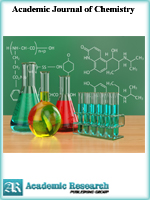Academic Journal of Chemistry
Online ISSN: 2519-7045
Print ISSN: 2521-0211
Print ISSN: 2521-0211
Quarterly Published (4 Issues Per Year)

Archives
Volume 5 Number 8 December 2020
Determination of Proximate Composition and Anti-Nutritional Content of Cassava in Jimma Zone Ethiopia
Authors: Adugna Bayata
Pages: 116-121
DOI: doi.org/10.32861/ajc.58.116.121
Abstract
Cassava is a dominant staple food for many developing countries, particularly, in humid and sub-humid tropics. In this study, the proximate composition and cyanide content of cassava tuber grown in Jimma Zone were investigated. Cassava samples were collected from five selected Woredas (Districts) of the Zone, where the plant usually grows. Nutritional compositions such as crude fat, protein, and fiber as well as cyanide contents were considered in this study. Accordingly, the crude fat, protein, and fiber content of the studied cassava root ranged from1.38-3.06%, 1.32-1.90%, and 1.58-2.96%, respectively. The results of the nutritional composition of analyzed cassava root samples were rich in crude fat, protein, fiber, and carbohydrate. The level of cyanide gives its value compared to the limits set by the World Health Organization was low and it may not cause harmful effect on human health.
Independent Sources of Information-Theoretic Descriptors of Electronic States
Authors: Roman F. Nalewajski
Pages: 106-115
DOI: doi.org/10.32861/ajc.58.106.115
Abstract
The need for resultant measures of the Information-Theoretic (IT) content of molecular electronic wavefunctions, combining the information contributions due to the probability and phase/current distributions, is reemphasized. Complementary measures of the state entropy (disorder) and information (order) contents are reexamined, the continuities of wavefunction components are summarized, and the probability acceleration concept is used to determine the current and information sources. The experimental elimination of the state uncertainties is discussed and limitations in this information-acquirement process imposed by the Heisenberg indeterminacy principle are commented upon.
Quantification of the Content of Ten (10) Brands of Metronidazole Infusion Marketed in Abuja Metropolis by UV Spectroscopic Method
Authors: Onavbavba Godspower ; Alemede Vincent Odunayo
Pages: 101-105
DOI: doi.org/10.32861/ajc.58.101.105
Abstract
The proliferation of substandard drugs is a major public health challenge, especially in developing countries which lacks adequate resources to effectively monitor their prevalence. Currently, there are no reliable statistics on the level of incidence of fake drugs in Nigeria. The quality of medicines is an integral part in ensuring that pharmaceutical products are fit for their intended use, comply with requirements of marketing authorization and do not expose consumers to risks. For this to be achieved, there must be a system of quality assurance, which incorporates aspects including product development, manufacturing, distribution, and storage. This study aimed at quantifying the content of ten (10) brands of metronidazole infusion marketed in Abuja by UV-Spectroscopic method. Ten (10) brands of metronidazole were purchased in different pharmacies within the city of Abuja and were assayed using UV-Spectroscopic method as stated in British Pharmacopoeia 2017 edition. All the ten (10) brands of metronidazole that were assayed had a percentage content of 100.97% to 108.15%. From the study carried out, all the brands of metronidazole infusion complied with the content uniformity test as stated in the British Pharmacopeia.



